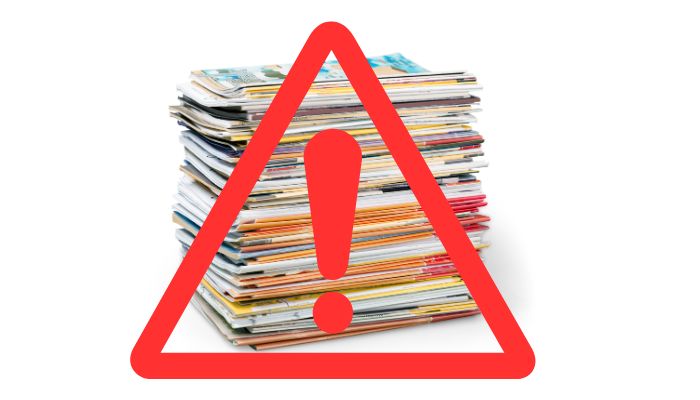Have you ever received a suspiciously official-looking renewal notice for a magazine subscription you don’t remember signing up for? Or perhaps you’ve been bombarded with relentless telemarketing calls trying to sell you subscriptions to magazines you’ve never even heard of? If so, you’re not alone. Welcome to the murky world of magazine subscription scams.
In this article, we’re going to dive headfirst into this deceptive realm, where scammers lurk behind glossy pages and persuasive pitches. We’ll uncover the tricks they use to reel you in and the red flags you should watch out for to avoid falling victim to their schemes. So grab a cup of coffee, get cozy, and let’s embark on this journey together to unveil the truth behind magazine subscription scams.

Common Tactics Used in Magazine Subscription Scams
Now that we’re all on the same page, let’s talk about the sneaky tactics these scammers employ to catch us off guard. First up, we have the notorious fake renewal notices. These deceptive documents often mimic the layout and language of legitimate renewal notices, making it easy to mistake them for the real deal. Before you know it, you’ve unwittingly renewed a subscription you never wanted in the first place.
Then there are the telemarketing scams that bombard us with persistent phone calls, urging us to subscribe to magazines we never knew existed. These smooth-talking scammers use high-pressure sales tactics to convince us that we’re getting a great deal, but in reality, we’re just lining their pockets with our hard-earned cash.
And let’s not forget about the door-to-door salesmen who show up uninvited, peddling magazine subscriptions like they’re the latest must-have gadget. They prey on our politeness and vulnerability, making it difficult to say no to their enticing offers.
But wait, there’s more! Online scams, subscription traps, and impersonation of legitimate companies are also part of the scammer’s playbook. Stay tuned as we delve deeper into each of these tactics and learn how to spot them before it’s too late.
Case Studies: Real-Life Examples of Magazine Subscription Scams
Let’s put theory into practice with some real-life examples of magazine subscription scams that have left unsuspecting victims scratching their heads. Take, for instance, the case of Mrs. Smith from Brisbane, Australia. She received a convincing renewal notice for a magazine she hadn’t subscribed to in years. Thinking it was a genuine reminder, she renewed the subscription, only to realize later that she had fallen prey to a clever scam. She has been in contact with local police and her lawyers, but so far, they have been unable to track down the perpetrators.
Then there’s Mr. Johnson from Brixton, U.K., who found himself on the receiving end of relentless telemarketing calls from a company claiming to offer exclusive deals on magazine subscriptions. Despite his initial skepticism, the smooth-talking salesperson managed to convince him to sign up for a bundle of magazines at a seemingly unbeatable price. Little did Mr. Johnson know, he was about to be hit with a monthly subscription fee that would drain his bank account.
And let’s not forget about Ms. Rodriguez, who answered her door one sunny afternoon to find a charming salesman offering discounted magazine subscriptions. Eager to support what she thought was a local business, she eagerly handed over her credit card details, only to later discover that the magazines never arrived and her money had vanished into thin air.
These are just a few examples of how magazine subscription scams can play out in real life. It’s essential to learn from these experiences and stay vigilant to avoid becoming the next victim.

Red Flags to Watch Out For
Now that we’ve seen how magazine subscription scams can unfold, let’s talk about the warning signs you should keep an eye out for to protect yourself from falling into the trap. First and foremost, be wary of any unsolicited calls or emails offering magazine subscriptions, especially if they pressure you to act quickly or provide payment information on the spot. Legitimate companies won’t resort to such aggressive tactics to secure your business.
High-pressure sales tactics are another red flag to watch out for. If a salesperson is pushing you to make a decision on the spot or refusing to take no for an answer, it’s a clear sign that something fishy is going on.
Unusual payment requests should also set off alarm bells. If a company asks you to pay for a magazine subscription using unconventional methods like wire transfers, cryptocurrency, or prepaid debit cards, proceed with caution. Legitimate businesses will typically accept payment via credit card or check.
Furthermore, always verify the contact information provided by the company. If they’re hesitant to provide a phone number or address, or if the information seems suspiciously vague, it’s best to steer clear.
Lastly, pay close attention to the fine print. Scammers often bury important details in the terms and conditions, hoping you won’t notice until it’s too late. Take the time to read through all the documentation carefully before committing to anything.
By keeping these red flags in mind and staying vigilant, you can protect yourself from falling victim to magazine subscription scams. Trust your instincts and don’t hesitate to walk away if something doesn’t feel right.

Protecting Yourself Against Magazine Subscription Scams
Armed with the knowledge of common tactics and red flags, you’re now better equipped to protect yourself from falling victim to magazine subscription scams. Here are a few tips to keep in mind:
Verify Legitimacy Before Subscribing: Always research the company offering the subscription and verify its legitimacy before providing any personal or payment information.
Be Skeptical of Unsolicited Offers: If you receive unsolicited calls or emails offering magazine subscriptions, approach them with caution and verify their authenticity before making any commitments.
Read the Fine Print Carefully: Take the time to thoroughly read through all terms and conditions before agreeing to any subscription. Pay attention to cancellation policies and renewal terms to avoid unexpected charges.
Keep Records of Transactions and Communications: Keep detailed records of any subscriptions you sign up for, including confirmation emails and receipts. This can help you dispute unauthorized charges and track your subscriptions more effectively.
Report Suspected Scams to Authorities: If you believe you’ve been targeted by a magazine subscription scam, don’t hesitate to report it to the relevant authorities, such as the Federal Trade Commission (FTC) or your state’s attorney general’s office.
Remember, staying informed and vigilant is your best defense against magazine subscription scams.
Conclusion
As we wrap up our exploration of magazine subscription scams, it’s clear that awareness and vigilance are crucial in protecting yourself from falling victim to these deceptive schemes. By familiarizing yourself with common tactics, recognizing red flags, and taking proactive steps to safeguard your personal information, you can significantly reduce your risk of being targeted by scammers.
Remember, you’re not alone in this fight against fraud. Share what you’ve learned with friends and family to help spread awareness and empower others to protect themselves as well.
And for an extra layer of protection, consider utilizing resources like Unknown Phone, a reputable website specializing in phone scam detection services. By leveraging technology and community-driven insights, you can stay one step ahead of scammers and keep your hard-earned money where it belongs – in your pocket.
Stay informed, stay vigilant, and together, we can outsmart the scammers and enjoy a safer, scam-free future.



